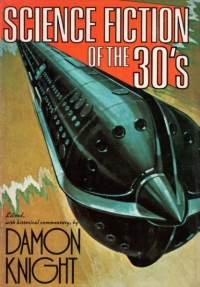
I’ve been reading a lot of retro Science Fiction recently. After Christmas, I was rooting around in my basement when I unearthed Damon Knight’s entertaining and informative Science Fiction of the Thirties. Damon Knight picked an interesting mix of stories and then wrote some brilliant introductions to the stories and the writers who composed them. I enjoyed Murray Leinster’s “The Fifth-Dimension Catapult” and “The Battery of Hate” by John W. Campbell, Jr. from The Early Years section. I was impressed by “The Last Man” by Frank Belknap Long and “The Mad Moon” by Stanley G. Weinbaum from The Middle Years. And I especially liked “Pithecanthropus Rejectus” by Manly Wade Wellman and “The Merman” by L. Sprague de Camp from The End of the Thirties. If you’re looking for a collection of somewhat dated, but still lively Science Fiction stories from a decade where SF really evolved, I recommend Damon Knight’s Science Fiction of the Thirties. GRADE: B+
TABLE OF CONTENTS:
“Foreword” (Damon Knight) xi
“The Early Years” (Damon Knight) 1
“Out Around Rigel” (Astounding Stories, December 1931) (Robert H. Wilson) 7
“The Fifth-Dimension Catapult” (Astounding Stories of Super-Science, January 1931) (Murray Leinster) 28
“Into the Meteorite Orbit” (Amazing Stories, December 1933) (Frank K. Kelly) 85
“The Battery of Hate” (Amazing Stories, November 1933) (John W. Campbell, Jr.). 115
“The Middle Period” (Damon Knight) 153
“The Wall” (Astounding Stories, May 1934) (Howard W. Graham) 157
“The Lost Language” (Amazing Stories, January 1934) (David H. Keller) 173
“The Last Men” (Astounding Stories, August 1934) (Frank Belknap Long, Jr.) 185
“The Other” (Astounding Stories, December 1934) (Howard W. Graham) 195
“The Mad Moon” (Astounding Stories, December 1935) (Stanley G. Weinbaum) 210
“Davey Jones’ Ambassador” (Astounding Stories, December 1935) (Raymond Z. Gallun) 234
“Alas, All Thinking” (Astounding Stories, June 1935) (Harry Bates) 269
“The Time Decelerator” (Astounding Stories, July 1936) (A. Macfadyen, Jr.) 307
“The Council of Drones” (Amazing Stories, October 1936) (William K. Sonnemann) 323
“The End” (Damon Knight) 363
“Seeker of Tomorrow” (Astounding Stories, July 1937) (Eric Frank Russell and Leslie T. Johnson) 367
“Hyperpilosity” (Astounding Science-Fiction, April 1938) (L. Sprague de Camp) 409
“Pithecanthropus Rejectus” (Astounding Stories, January 1938) (Manly Wade Wellman) 423
“The Merman” (Astounding Science-Fiction, December 1938) (L. Sprague de Camp) 435
“The Day Is Done” (Astounding Science-Fiction, May 1939) (Lester del Rey) 451
“Bibliography” 465
It’s a nice contrast to Asimov’s and sone of the other ’30s anthologies. Asimov and particularly Knight have a better filter in place than, say, Moskowitz or Ackerman.
Todd, you’re right. Moskowitz especially featured pulpy stories in most of his anthologies. Ackerman preferred space monsters. Knight had more sophisticated tastes.
I’ve owned Science Fiction of the 30’s for years, but haven’t gotten around to read it yet. George, your comments make me want to get it out. I have read Before the Golden Age edited by Isaac Asimov, so I have a feel for the era. It is distinctly different.
Jim, I’ve owned SCIENCE FICTION OF THE THIRTIES for at least as long as you have, but I finally sat down and read it last week. The 1930s was a developmental decade for Science Fiction. Plenty of changes! I have a copy of BEFORE THE GOLDEN AGE around here somewhere, too.
Nice one. I’ve read several of the authors but probably not any of the specific stories.
Jeff, the SF stories from the 1930s have a different feel from SF stories from the 1920s and SF stories from the 1940s. The genre was evoking and plenty of writers took risks with their writing.
George
It’s anthologies like this one which have allowed me to sell off my set of ASTOUNDING pulps from the 30s. They give me a chance to read the better stories, if not the best ones, without having to brush off all those small bits of pulp paper afterward.
Steve, I donated my complete runs of GALAXY, WORLDS OF TOMORROW, etc. to SUNY at Buffalo for the same reasons. There are plenty of anthologies that collect the best stories. And, although I love the cover artwork on those old SF magazines, there are plenty of collections of vintage SF artwork, too. Space and storage become problems with large collections, as you well know.
I have this and have read it, though these are a decade older than the works I prefer.
Rick, the writing quality of SF improved in the 1940s and 1950s. In the 1960s, SF tended to start to migrate to more novels.
Which by no means lessened the quality of the short fiction in the field. The novels, in fact, have always been more variable, even among the best writers…in part because the short fiction has often been work done for love and occasionally as the working out of what was later incorporated into novels…not always to the benefit of the work (true of Walter Miller’s work, and true of that of a lot of others).
Todd, you are so right! Some SF writers loved the short form. Jack Vance did, as did Clifford Simak. I’ll be featuring Robert Silverberg’s time travel stories in an upcoming FFB. Silverberg, who wrote many SF novels, still worked to produce high quality short fiction during his most productive years.
Someone somewhere recently noted that there is more sf short fiction from most of the previous decades in print than the novels…a variety of reasons for that…